
A catafalque is a raised bier, box, or similar platform, often movable, that is used to support the casket, coffin, or body of a dead person during a Christian funeral or memorial service. Following a Roman Catholic Requiem Mass, a catafalque may be used to stand in place of the body at the absolution of the dead or used during Masses of the Dead and All Souls' Day.
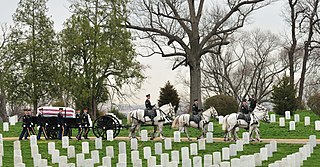
A military funeral is a memorial or burial rite given by a country's military for a soldier, sailor, marine or airman who died in battle, a veteran, or other prominent military figures or heads of state. A military funeral may feature guards of honor, the firing of volley shots as a salute, drumming and other military elements, with a flag draping over the coffin.
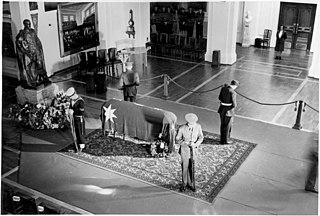
A state funeral is a public funeral ceremony, observing the strict rules of protocol, held to honour people of national significance. State funerals usually include much pomp and ceremony as well as religious overtones and distinctive elements of military tradition. Generally, state funerals are held in order to involve the general public in a national day of mourning after the family of the deceased gives consent. A state funeral will often generate mass publicity from both national and global media outlets.

The 3rd United States Infantry Regiment is a regiment of the United States Army. It currently has three active battalions, and is readily identified by its nickname, The Old Guard, as well as Escort to the President. The regimental motto is Noli Me Tangere. The regiment is a major unit of the Military District of Washington (MDW).

On June 5, 2004, Ronald Reagan, the 40th president of the United States, died after having Alzheimer's disease for nearly a decade. Reagan was the first former U.S. president to die in 10 years since Richard Nixon in 1994. At the age of 93 years, 120 days, Reagan was the longest-lived U.S. president in history at the time of his death, a record which was surpassed by Gerald Ford on November 12, 2006. His seven-day state funeral followed. After Reagan's death, his body was taken from his Bel Air home to the Kingsley and Gates Funeral Home in Santa Monica, California, to prepare the body for burial. On June 7, Reagan's casket was transported by hearse and displayed at the Ronald Reagan Presidential Library in Simi Valley, California, then flown to Washington, D.C., on June 9 for a service, public viewing and tributes at the U.S. Capitol.

The United States Army Military District of Washington (MDW) is one of nineteen major commands of the United States Army. Its headquarters are located at Fort Lesley J. McNair in Washington, D.C. The missions of the units in the Military District of Washington include ceremonial tasks as well as a combat role in the defense of the National Capital Region.
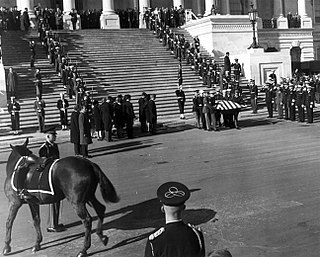
A coal-black Morgan-American Quarter Horse cross, Black Jack served in the Caisson Platoon of the 3rd U.S. Infantry Regiment. Named in honor of General of the Armies John J. "Black Jack" Pershing, he was the riderless horse in more than 1,000 Armed Forces Full Honors Funerals (AFFHF), the majority of which were in Arlington National Cemetery. With boots reversed in the stirrups, he was a symbol of a fallen leader.
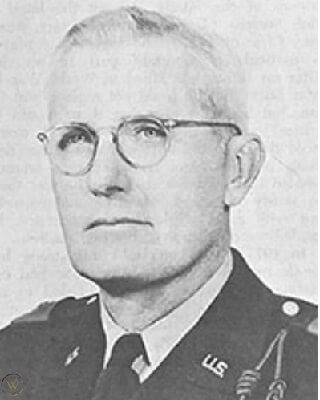
Philip Campbell Wehle was a major general in the U.S. Army and the commanding general of the Military District of Washington (MDW) from 1963 to 1965.
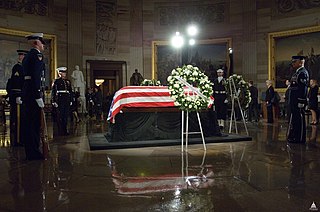
On December 26, 2006, Gerald Ford, the 38th president of the United States, died at his home in Rancho Mirage, California at 6:45 p.m. local time. At 8:49 p.m. local time, his wife of 58 years, Betty Ford, issued a statement announcing his death. The causes of death listed on the death certificate were arteriosclerotic cerebrovascular disease and diffuse arteriosclerosis.
Harry Rozmiarek was a noted veterinarian, academic, and laboratory animal care specialist.

In the United States, state funerals are the official funerary rites conducted by the federal government in the nation's capital, Washington, D.C., that are offered to a sitting or former president, a president-elect, high government officials and other civilians who have rendered distinguished service to the nation. Administered by the Military District of Washington (MDW), a command unit of the Joint Force Headquarters National Capital Region, state funerals are greatly influenced by protocol, steeped in tradition, and rich in history. However, the overall planning as well as the decision to hold a state funeral, is largely determined by a president and their family.
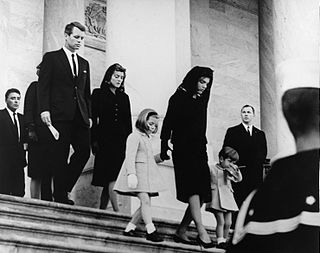
The state funeral of U.S. President John F. Kennedy took place in Washington, D.C., during the three days that followed his assassination on Friday, November 22, 1963, in Dallas, Texas.

Joint Base Myer–Henderson Hall is a joint base of the United States Armed Forces, located across multiple sites in the National Capital Region. It is jointly made up of is made up of Fort Myer, Fort McNair, and Henderson Hall (in Arlington]]. It is the local residue of the Base Realignment and Closure, 2005 process. It is commanded by the United States Army but has resident commands of Army, Navy, & Marines. Most conspicuous is the Arlington National Cemetery Honor Guard.
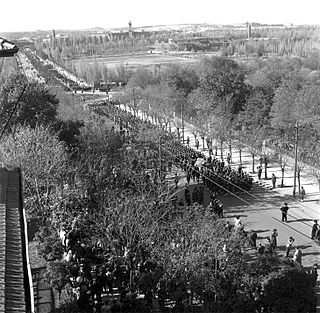
Mustafa Kemal Atatürk, the first president of the Republic of Turkey, died at the Dolmabahçe Palace, his official residence in Istanbul, on 10 November 1938. His state funeral was held in the capital city of Ankara on 21 November, and was attended by dignitaries from seventeen nations. His body remained at the Ethnography Museum of Ankara until 10 November 1953, the fifteenth anniversary of his death, when his remains were carried to his final resting place at Anıtkabir.

A military funeral in the United States is a memorial or burial rite conducted by the United States Armed Forces for a Soldier, Marine, Sailor, Airman, Guardian or Coast Guardsman who died in battle, a veteran, or other prominent military figures or a president. A military funeral may feature guards of honor, the firing of volley shots as a salute, drumming and other military elements, with a flag draping over the coffin.

Old Bob or Old Robin was a driving horse used by Abraham Lincoln during the period prior to his presidency of the United States. He later participated in Lincoln's funeral. Old Bob's exact fate and date of death are unknown; he was sold to drayman John Flynn by Lincoln in 1860.

Abraham Lincoln's hearse (New York) was the purpose-constructed hearse built to carry the body of Abraham Lincoln during a cortège held in New York City on April 25, 1865, shortly after his assassination by John Wilkes Booth. It has been described as the most elaborate of the many hearses used to transport Lincoln's body during the two-week funeral tour which preceded his burial in Springfield, Illinois.

Kennedy is an American Standardbred horse who was owned by the United States Army.

Sergeant York is a retired horse that was previously owned by the United States Army.



















